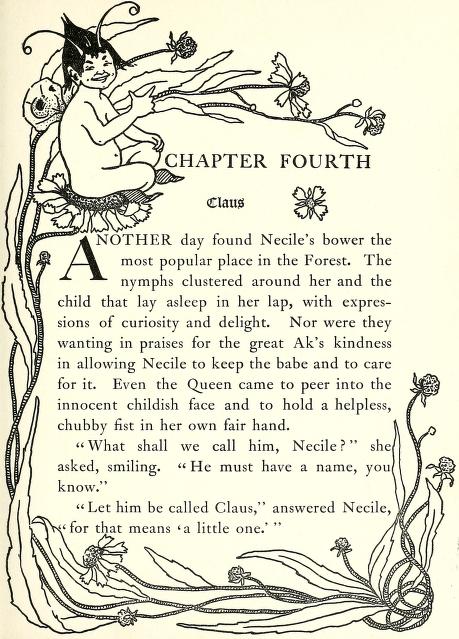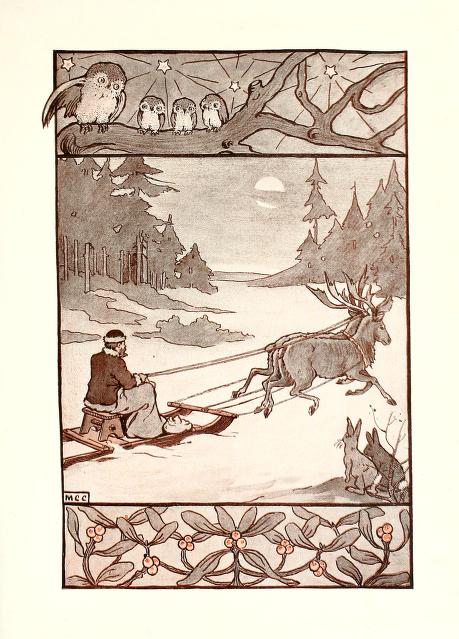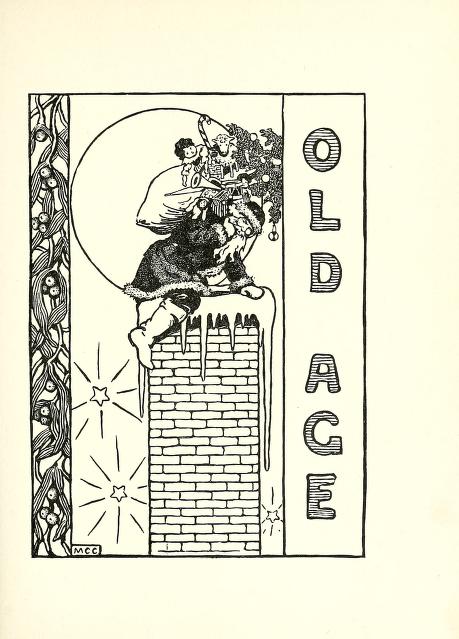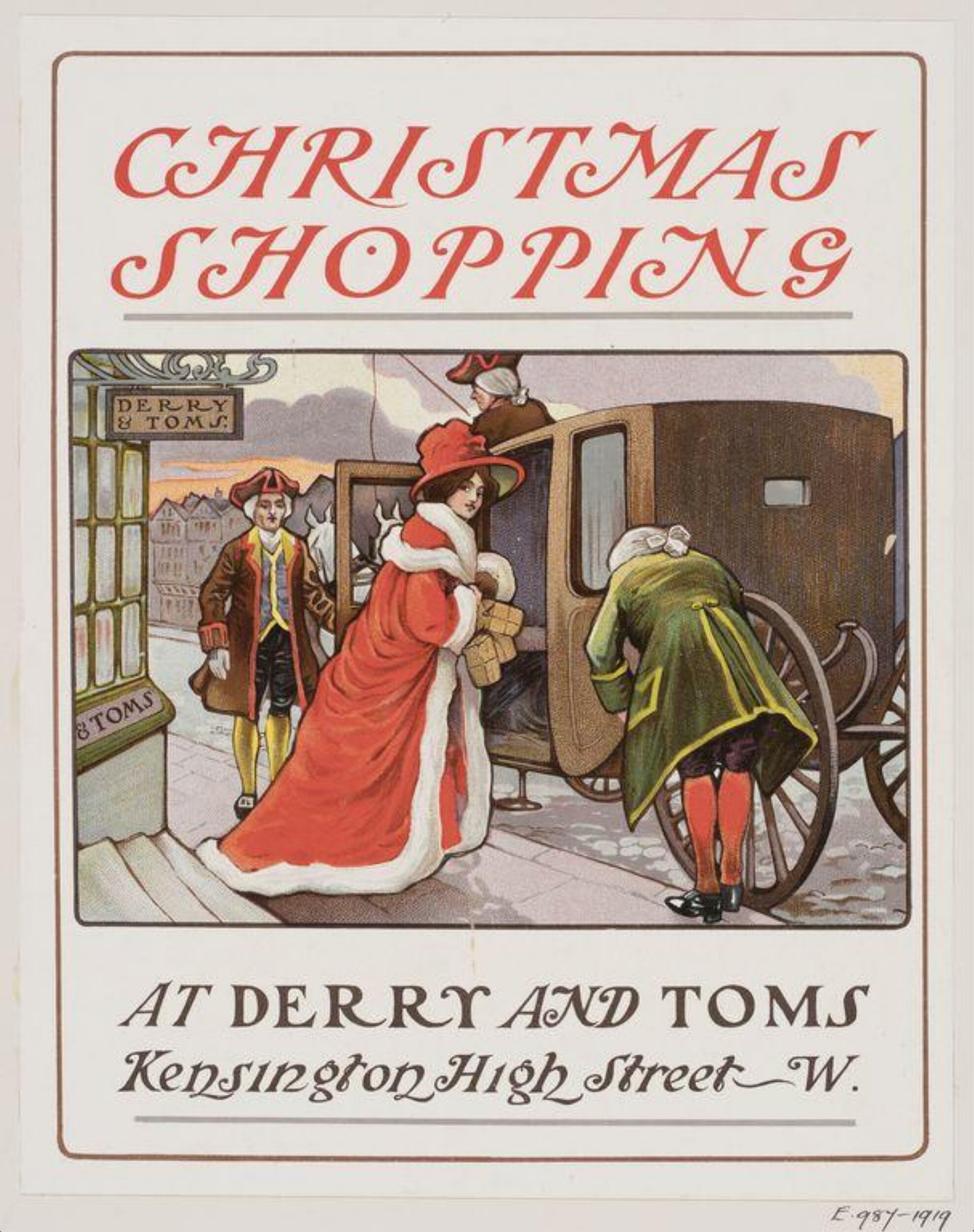Did you know that Wizard of Oz author L. Frank Baum wrote an entire novel on the life and times of Santa Claus? I had never heard this before and came across a reference to it while doing some online research on the history of Mother Goose. The novel, The Life and Adventures of Santa Claus, opens with a telling of Santa’s adoption as an infant and follows his story in great detail. I was blown away by this discovery and thought I might do a post on this obscure origin story as a Christmas in July gift to our readers.
The Life and Adventures of Santa Claus by Frank Baum

I haven’t seen many books or films that go into what Santa was like as a child! It is fascinating to me that Baum went into so much detail about this.
As a lifelong fan of fairy lore, I was so delighted to learn that Baum’s origin story tells of Santa being rescued by a fairy named Necile who is then granted permission to adopt him when he is found alone in the woods. It is Necile who gave Santa his very unique name.
“What shall we call him, Necile?” she asked, smiling. “He must have a name, you know.”
“Let him be called Claus,” answered Necile, “for that means ‘a little one.'”
“Rather let him be called Neclaus,” returned the Queen, “for that will mean ‘Necile’s little one.'”
The nymphs clapped their hands in delight, and Neclaus became the infant’s name, although Necile loved best to call him Claus, and in afterdays many of her sisters followed her example.”

For many years he lived happily in the magical forest among the fairies, knowing nothing of the outside world. He does eventually come to learn of other humans and how they live, thanks to trips he would take with “Master Woodsman,” who appears to be a mentor of sorts to the young boy. Santa notices that some children live in opulence and others in squalor, but that their hearts are all pure. He thus begins to develop both curiosity and compassion for all of them. This compassion would develop and mature over time, with Santa first bringing toys just to poor children and then deciding that even the rich deserve extra pleasantries around Christmas.
Nearing adulthood Santa discovers that his purpose in life is to enter the outside world and bring joy to the children of the world. He approaches the king of the fairyland and requests a blessing from his fairy family to leave the forest. When asked what he will do he responds:
“I must devote myself to the care of the children of mankind, and try to make them happy…Since your own tender care of a babe brought to me happiness and strength, it is just and right that I devote my life to the pleasure of other babes. Thus will the memory of the loving nymph Necile be planted within the hearts of thousands of my race for many years to come, and her kindly act be recounted in song and in story while the world shall last.”
His adopted family accepts his wishes and encourages him to pursue his passion. So Santa enters the human world and quickly gains a reputation as a caring man who is quite good with children:
“So the children romped and played games with Claus, and the boys rode upon his shoulders, and the girls nestled in his strong arms, and the babies clung fondly to his knees. Wherever the young man chanced to be, the sound of childish laughter followed him; and to understand this better you must know that children were much neglected in those days and received little attention from their parents, so that it became to them a marvel that so goodly a man as Claus devoted his time to making them happy. And those who knew him were, you may be sure, very happy indeed. The sad faces of the poor and abused grew bright for once; the cripple smiled despite his misfortune; the ailing ones hushed their moans and the grieved ones their cries when their merry friend came nigh to comfort them.”
Thought of course his actions were met with just a bit of skepticism by some:
“the parents, while they regarded the young man with some scorn for loving children more than their elders, were content that the girls and boys had found a playfellow who seemed willing to amuse them.”

The next several chapters are full of stories of Santa discovering his knack for making toys and the origin of many traditions associated with Santa such as stockings, reindeer, and Christmas trees. The story of how he came to use reindeer for long-distance delivery of toys is especially amusing. Santa was of course already friends with a number of reindeer and one night one of them saw him about to embark on a delivery of many miles:
“Then the snow would melt before you could get back,” said the deer. “You must wait until spring, Claus.”
Claus sighed. “Had I your fleet feet,” said he, “I could make the journey in a day.”
“But you have not,” returned Glossie, looking at his own slender legs with pride.
“Perhaps I could ride upon your back,” Claus ventured to remark, after a pause.
“Oh no; our backs are not strong enough to bear your weight,” said Flossie, decidedly. “But if you had a sledge, and could harness us to it, we might draw you easily, and your pack as well.”
“I’ll make a sledge!” exclaimed Claus. “Will you agree to draw me if I do?”
“Well,” replied Flossie, “we must first go and ask the Knooks, who are our guardians, for permission; but if they consent, and you can make a sledge and harness, we will gladly assist you.”
“Then go at once!” cried Claus, eagerly. “I am sure the friendly Knooks will give their consent, and by the time you are back I shall be ready to harness you to my sledge.”
It is shortly after that, upon discovering that some of the doors in the more distant areas are kept locked at night that the reindeer suggest he use the chimney and then demonstrate how they are able to fly to the rooftops.
As for Christmas trees, Santa came up with the idea to leave a tree at the home of a family living in a desert area as a special treat. He was so pleased with the results that he decided to start leaving them at more homes. People loved it and the tradition took off.
He’s not making a list or checking it twice
According to Baum’s version, the notion that Santa Claus uses gift-giving as a way to punish or reward children for good behavior was a story invented by parents as his reputation grew.
“And afterward, when a child was naughty or disobedient, its mother would say:
“You must pray to the good Santa Claus for forgiveness. He does not like naughty children, and, unless you repent, he will bring you no more pretty toys.”
But Santa Claus himself would not have approved this speech. He brought toys to the children because they were little and helpless, and because he loved them. He knew that the best of children were sometimes naughty, and that the naughty ones were often good. It is the way with children, the world over, and he would not have changed their natures had he possessed the power to do so.”
A legend that will never die

As Santa grows old he is granted immortality by a council of fairies. But as he is at this time quite aged, he selected a handful of “deputies” to help carry on his work as he retires to enjoy his life in the forest.
Get more of The Life and Adventures of Santa Claus:
Audiobook – four different versions
Get the fully illustrated paperback version
More Christmas in July fun:
The anatomy of a perfect Mrs. Claus costume
The 12 Days of Christmas: more than just a song














Leave A Comment